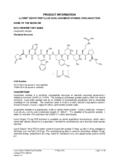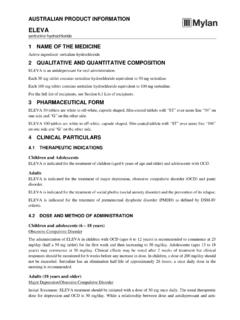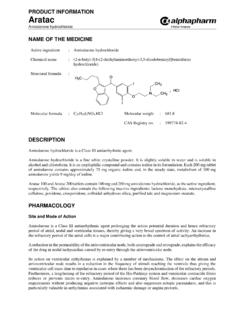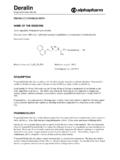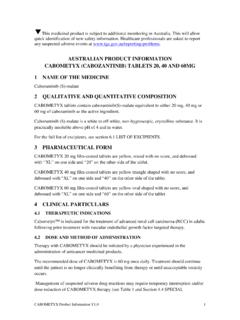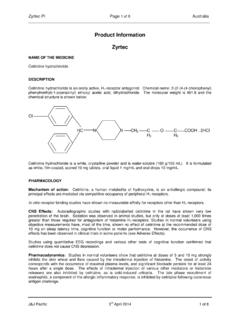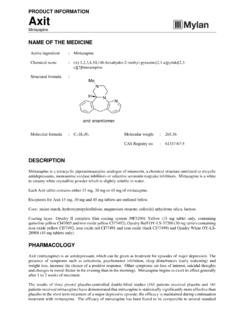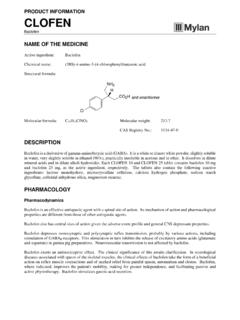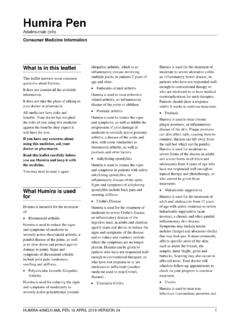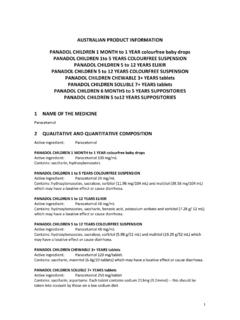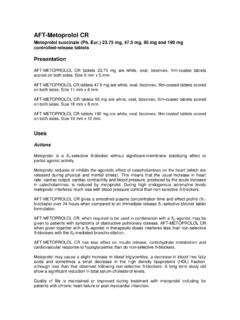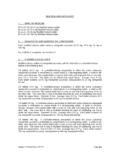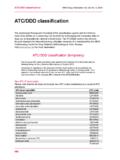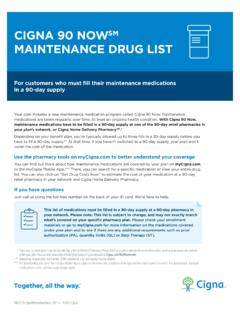Transcription of AUSTRALIAN PI APO-METOPROLOL (METOPROLOL …
1 1 AUSTRALIAN PI APO-METOPROLOL ( metoprolol TARTRATE) 1 NAME OF THE MEDICINE metoprolol tartrate 2 AND 3 QUALITATIVE AND QUANTITATIVE COMPOSITION AND PHARMACEUTICAL FORM metoprolol tartrate is a white, crystalline powder with a melting point of approximately 120 C. The powder is practically odourless. It is very soluble in water, soluble in chloroform, methylene chloride and alcohol, and almost insoluble in benzene, diethylether and acetone. metoprolol tartrate is structurally related to other cardioselective -blockers.
2 Each tablet contains either 50 mg or 100 mg of metoprolol tartrate as the active ingredient. In addition, each tablet contains the following inactive ingredients: lactose monohydrate, colloidal anhydrous silica, microcrystalline cellulose, croscarmellose sodium, pregelatinised maize starch, sodium starch glycollate, magnesium stearate, hypromellose, purified talc, macrogol 400 and titanium dioxide. The 50 mg strength tablets also contain iron oxide red. 50 mg tablet: Pink, round, biconvex film-coated tablets with notch break line on one side and 50 debossed on other side.
3 100 mg tablet: White to off-white, round, biconvex film-coated tablets with notch break line on one side and 100 debossed on other side. 4 CLINICAL PARTICULARS THERAPEUTIC INDICATIONS Hypertension: as monotherapy or for use in combination with other antihypertensives. Angina pectoris: for long-term prophylaxis. Glyceryl trinitrate should be employed if necessary for alleviating acute attacks. Suspected or definite myocardial infarction. Migraine prophylaxis. DOSE AND METHOD OF ADMINISTRATION The maximum daily dose should not exceed 400 mg.
4 Although twice daily dosage is optimal, in those patients whose maintenance dosage is 150 mg daily or less, it may be administered as a single dose. It is advisable to individualise the dosage. The film coated tablets should be swallowed whole. Hypertension Mild: 50 or 100 mg, given once daily, for one week Moderate to severe: 50 or 100 mg, given twice daily for one week Maintenance: 50 or 100 mg, given once or twice daily. 2 Some patients may respond to 50 mg once daily. However, a large number of patients will respond to 100 mg, given once daily as initial and maintenance therapy.
5 Response is rarely improved by increasing the dose beyond 200 mg daily. Angina Pectoris 50 mg to 100 mg, given two or three times daily Myocardial Infarction The recommended dosage can be reduced depending on the haemodynamic status of the patient. Initially Therapy should commence with 50 mg twice daily and be continued for 48 hours. Maintenance Generally 100 mg, given twice daily. Migraine Prophylaxis 100 to 150 mg, given in two divided doses (morning and evening). CONTRAINDICATIONS Bronchospasm -adrenergic blockade of the smooth muscle of bronchi and bronchioles may result in an increased airways resistance.
6 These medicines also reduce the effectiveness of asthma treatment. This may be dangerous in susceptible patients. Therefore, -blockers are contraindicated in any patient with a history of airways obstruction or a tendency to bronchospasm. Use of cardioselective -blockers can also result in severe bronchospasm. If such therapy must be used, great caution should be exercised. Alternative therapy should be considered. Allergic disorders (including allergic rhinitis) which may suggest a predisposition to bronchospasm Right ventricular failure secondary to pulmonary hypertension Significant right ventricular hypertrophy Sinus bradycardia (less than 45 50 beats/minute) Second or third degree atrioventricular (A-V) block Shock (including cardiogenic and hypovolaemic shock) Hypersensitivity to metoprolol , related derivatives or any of the excipients in metoprolol .
7 Cross-sensitivity between -blockers can occur. Congestive heart failure (see also warnings and precautions for use) Sick-sinus syndrome (unless a permanent, appropriately functioning pacemaker is in place) Severe peripheral arterial circulatory disorders Myocardial infarction patients with a heart rate of < 45 beats/min., a P-R interval of > seconds, a systolic blood pressure of <100 mm Hg and/or moderate to severe heart failure Hypotension Untreated phaeochromocytoma (see warnings and precautions for use)
8 Continuous or intermittent inotropic therapy acting through -receptor agonism SPECIAL WARNINGS AND PRECAUTIONS FOR USE Cardiac Failure -blockade depresses myocardial contractility and may precipitate cardiac failure in some patients with a history of cardiac failure, chronic myocardial insufficiency or unsuspected cardiomyopathy. In patients without a history of cardiac failure, continuing depression of the 3 myocardium may lead to cardiac failure. If signs of cardiac failure are present, the patient should be fully digitalised and/or given a diuretic and carefully monitored.
9 If cardiac failure persists, metoprolol should be discontinued gradually (see warnings and precautions for use, Abrupt Withdrawal). -blockers should not be used in patients with untreated congestive heart failure. This condition should first be stabilised. Although congestive heart failure has been considered to be a contraindication to the use of -blockers, there is a growing literature on the experimental use of -adrenergic blocking medicines in heart failure. As further trials are needed to identify which patients are most likely to respond to which medication, -blockers should not normally be prescribed for heart failure outside of specialist centres.
10 Myocardial Infarction In patients with myocardial infarction, if significant hypotension occurs, metoprolol should be discontinued and the hemodynamic status of the patient, and the extent of myocardial ischemia, carefully assessed. Intensive hemodynamic monitoring may be required and appropriate treatment modalities should be instituted. If hypotension is associated with significant bradycardia or atrioventricular block, treatment should be directed at reversing these. Prinzmetal Angina There is a risk of exacerbating the number and duration of coronary artery spasms if patients with Prinzmetal angina or variant angina pectoris are treated with a -blocker, including metoprolol .
